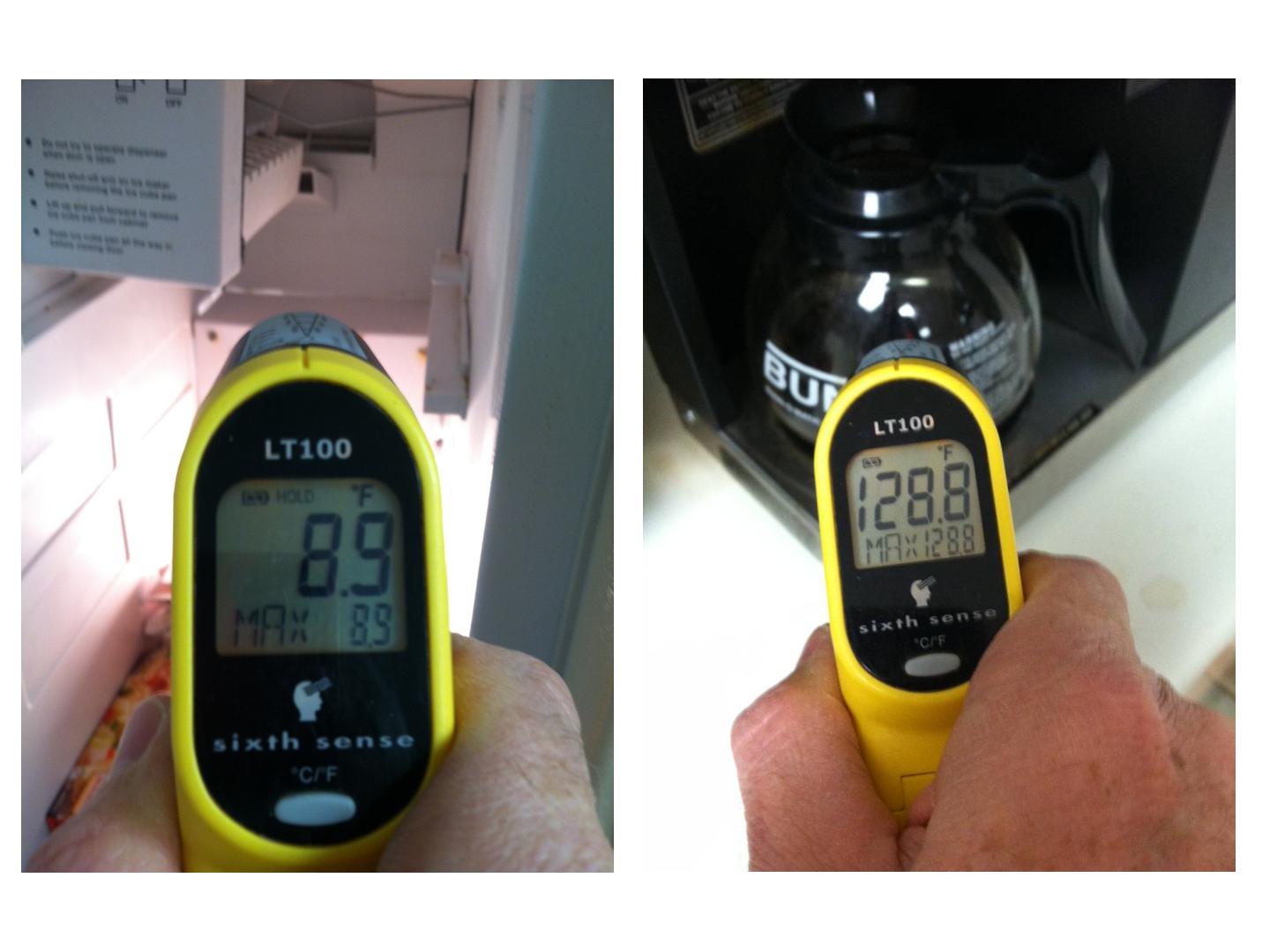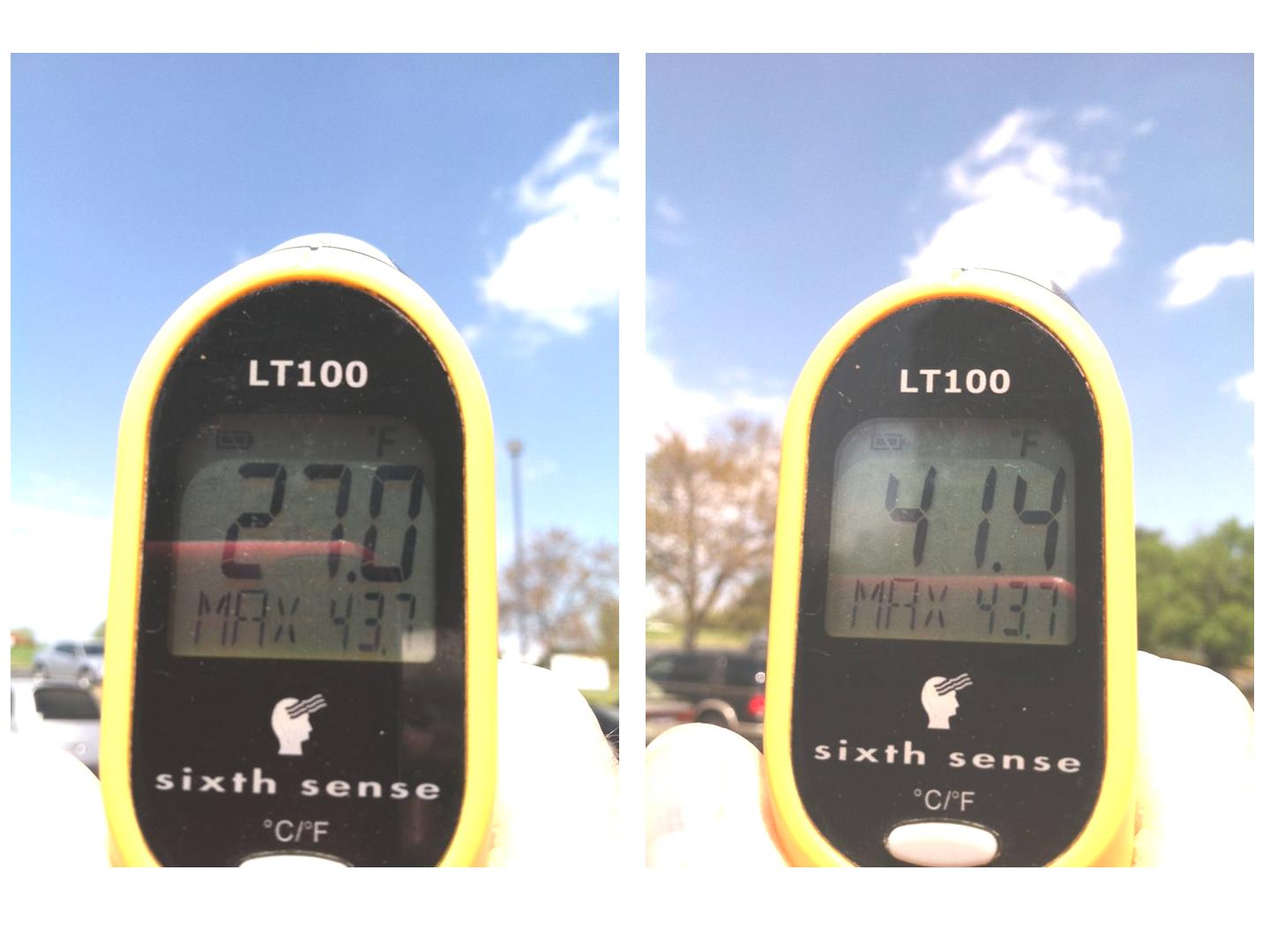After yesterday’s post about what determines temperature, I thought I would revisit one of the most convincing evidences of Earth’s greenhouse effect.
As I’ve mentioned before, a handheld infrared thermometer is a great little tool to help gain physical insight into the thermal radiative (infrared) effect the atmosphere has on surface temperature.
Here I’m going to give an example of how the IR thermometer responds to a clear sky versus a cloud, and I invite alternative ideas of what is causing the resulting indicated temperature changes.
First, I want to demonstrate how the IR thermometer does indeed respond, remotely, to the temperature of any object it is pointed at. I made the following measurements inside our break room freezer (reading about 9 deg. F), and while pointed at the coffee pot (reading about 129 deg. F):

(I’m not going to address the absolute accuracy of the measurements, which is probably not better than a few degrees, since we will be dealing with temperature changes of ten of degrees or more. If you work with these things enough you will see they are sensitive to changes smaller than 1 deg. F.)
Then, I took measurements outside our UAH building while pointing the IR thermometer at the sky. For reference, the ambient air temperature at our weather station about 100 ft away was 78 deg. F, and the dewpoint was 63 deg. F.
The thermometer is pointed first at a clear patch of sky (reading 27 deg. F), and then an adjacent cloud (reading 41 deg. F):

Now, my question is this:
What caused the IR thermometer reading to warm up by 14 deg. when it went from clear sky to the cloud?
I’m especially interested to hear an answer from those who tell me there is no such thing as downwelling sky radiation (aka “back radiation”). No matter what you believe is happening, it is rather obvious that the cloud influences the temperature reading differently than clear sky. (If you are thinking it is a reflected sunlight effect, you can perform the experiment at night and see the same effect; furthermore, the highest cloud temperatures you will get are from the thickest, *blackest* clouds on the bottom…so it’s not a reflected sunlight effect).
What Does the IR Thermometer Actually Measure?
As I mentioned in my previous post “What Determines Temperature?”, temperature is an energy budget issue, the result of energy gain versus energy loss.
Inside the IR thermometer, there is a thermopile (an electronic circuit very sensitive to temperature differences) with thermistors measuring temperature at both ends. When you point the thermometer at an object with a different temperature than the thermopile, an IR lens (which has a beamwidth of about 5 deg.) allows IR radiation to flow between the lens end of the thermopile and the target object.
If the target object is warmer than the viewing end of the thermopile, the net IR flow is from the object toward the thermopile, which begins to warm. Circuitry measures how fast those temperature changes occur and extrapolates an estimate of the target object’s temperature. (The thermometer has no idea what the infrared emissivity of the object is, so my unit simply assumes an emissivity of 0.95).
If the target object is colder than the thermocouple, the net flow of IR radiation is from the thermocouple to the object, and the thermocouple cools.
In the cloud case, the cloud has a higher emitting temperature because it is at a lower altitude, and it is more opaque in the infrared than the clear sky is.
A similar effect can be achieved from just the clear sky, by pointing the IR thermometer up at different elevation angles. Increasing temperatures will be indicated as the elevation angle is lowered toward the horizon. Today, I measured about 15 deg. F pointing straight up to about 35 deg. F when pointed about 20 deg. above the horizon.
In this clear-sky case, infrared absorbers/emitters (aka “greenhouse gases”) in the atmosphere, which are partly (but not totally) transparent at the IR frequency band the thermometer is tuned to, become more opaque as the thermometer is pointed at lower elevation angles. As the elevation angle is lowered, the path length through the atmospheric absorbers increases, and the altitudes from which the IR emission is being received are lower and thus at higher emitting temperatures.
This is the most convincing, do-it-yourself, direct observational evidence of downwelling sky radiation I have been able to find, and it makes a great little science experiment for students. What makes it “direct” evidence is that it actually measures the surface temperature effect (at surface of the thermopile) of changing downwelling IR radiation from the sky. This is the same thing happening continuously at the surface of the Earth as the strength of the greenhouse effect changes from water vapor, clouds,..oh yeah, and carbon dioxide.
And if you STILL don’t see how this demonstrates the greenhouse effect, imagine what would happen if you suddenly removed all of that atmosphere and clouds: there would be a sudden increase in the rate of net IR flow from the surface of the Earth to outer space, and temperatures would drop. THAT is the greenhouse effect.
For those who do not believe the above explanation, give us your alternative answer to the question: what causes the IR thermometer indicated temperature to increase from (1) clear sky to cloud, and (2) zenith clear sky to low-elevation clear sky?

 Home/Blog
Home/Blog




Let me put it this way. The Earth has an amazing temperature range. It is so amazing that humans and other species can survive on Earth with relatively little trouble from the cold or heat. In fact, you could say it was man-made but we all know it wasn’t!
Humans and other species, some of which are already dying or have become extinct, cannot have an Earth that is too hot. We will not survive.
So if the planet is not warming we will be ok.
So if the planet is not cooling we will be ok.
The problem lies in the “if”.
What if we are experiencing gradual warming? One that is slow and relatively unobvious to most people. Atmospheric CO2 was necessary for human evolution. Too much atmospheric CO2 will see human extinction.